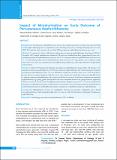Please use this identifier to cite or link to this item:
https://hdl.handle.net/20.500.14356/1406| Title: | Impact of Miniaturization on Early Outcome of Percutaneous Nephrolithotomy |
| Authors: | Adhikari, Mahesh Bahadur Karna, Sumeet Adhikari, Kinju Kasaju, Atul Baidya, Jagdish Lal |
| Citation: | AdhikariM. B., KarnaS., AdhikariK., KasajuA., & BaidyaJ. L. (2019). Impact of Miniaturization on Early Outcome of Percutaneous Nephrolithotomy. Journal of Nepal Health Research Council, 17(3), 320-324. https://doi.org/10.33314/jnhrc.v17i3.1593 |
| Issue Date: | 2019 |
| Publisher: | Nepal Health Research Council |
| Article Type: | Original Article |
| Keywords: | Endourology Percutaneous nephrolithotomy PNL Urolithiasis |
| Series/Report no.: | July-Sep, 2019;1593 |
| Abstract: | Abstract Background: Percutaneous nephrolithotomy has become the standard procedure for large renal stones but still remains highly challenging due to complications such as bleeding and sepsis, even though it has high stone free rate (SFR). We report the early outcomes of more than 1000 percutaneous nephrolithotomys done in our center. Methods: A retrospective study of all patients undergoing percutaneous nephrolithotomy from January 2010 to December 2017 in single institution was conducted. All cases were stratified into three groups based on tract size; standard percutaneous nephrolithotomy with tract size ? 22 F, mini percutaneous nephrolithotomy with tract size 15 – 20 F and ultramini percutaneous nephrolithotomy with tract size ? 14 F. Age, gender, stone complexity using Guy’s stone score, stone size, operative time, hemoglobin drop, hospital stay, early major and minor complications were reviewed. Results: A total of 1074 patients had undergone percutaneous nephrolithotomy among which, 578 patients were standard percutaneous nephrolithotomy, 433 mini percutaneous nephrolithotomy and 63 had undergone ultramini percutaneous nephrolithotomy. There was even distribution of patients with Guy’s stone score 1 and 2 in all three groups. However, majority of patients with Guy’s stone score 3 underwent standard percutaneous nephrolithotomy or mini percutaneous nephrolithotomy and no patients with Guy’s stone score 4 underwent ultramini percutaneous nephrolithotomy. Age group, gender and operative time were comparable between the groups; however, significant difference was noted in terms of less hemoglobin drop and shorter hospital stay (p-value < 0.05) in the miniaturized percutaneous nephrolithotomy group. Complications were found to be fewer in mini percutaneous nephrolithotomy and ultramini percutaneous nephrolithotomy group in comparison to standard percutaneous nephrolithotomy. Conclusions: Miniaturization of tract size significantly decreases post-operative complication rates, blood loss and hospital stay while maintaining high stone free rates in well selected patients undergoing Percutaneous nephrolithotomy. Keywords: Endourology; percutaneous nephrolithotomy; PNL; urolithiasis. |
| Description: | Original Article |
| URI: | http://103.69.126.140:8080/handle/20.500.14356/1406 |
| ISSN: | Print ISSN: 1727-5482; Online ISSN: 1999-6217 |
| Appears in Collections: | Vol. 17 No. 3 Issue 44 Jul-Sep 2019 |
Files in This Item:
| File | Description | Size | Format | |
|---|---|---|---|---|
| 1593-Manuscript-12203-1-10-20191114.pdf | Fulltext Download | 279.15 kB | Adobe PDF |  View/Open |
Items in DSpace are protected by copyright, with all rights reserved, unless otherwise indicated.
